Countertops
The horizontal surfaces in your kitchen actually take as much or more wear and tear than your cabinets. I find that there are a lot more people that know what they want when it comes to countertops than when they are talking about cabinetry. There are pro's and con's to every surface and you will have to analyze which one will fit your needs best. A lot of real estate professionals will replace a countertop to spruce up an older home and paint out the cabinets to make it look new, but in the long run should you discover that you have a Mercedes countertop on a Pinto cabinet, you may not be able to save the countertop when you replace the cabinets. In other words, you're stuck unless you have a patient and talented contractor. But there are no guarantees that you can remove a granite countertop without cracking it. So before you replace your counters, be sure you can live with your cabinets for another 20 years.
Laminate: Better known as "Formica", which is a brand name like "Kleenex", plastic laminate is the most inexpensive choice. Years ago, it was just about the only choice. I have found that many people want to up-grade from laminate to another surface. But if you are on a tight budget, putting in a laminate countertop and changing it down the road may help you in the long run. Laminate is made of paper, chemicals, heat and pressure. You definitely want a high pressure laminate for horizontal surfaces. Low pressure is fine for the interior of cabinets, but not countertops. Laminates will come in solid colors as well as patterns and there are several companies that each has their own color selections. The laminate is affixed to a particle board substrate with glue, so ask the fabricator if they have a green option if you are concerned with your indoor air quality. With a laminate countertop, you will not have the option of under-mounting your sink. It will have to be a top mount, or self-rimming type, or one with a
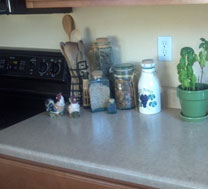
Tile: Ceramic tiles an upgrade from laminate because it is more durable and you can put hot pots on it and even cut on it (although you will ruin your knives). But, if you
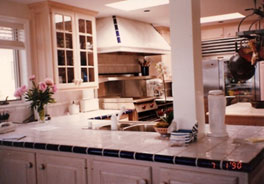
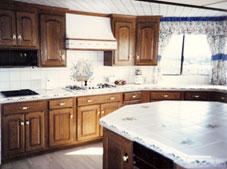
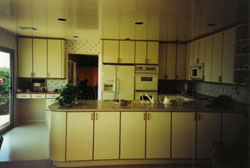
Solid surface: Dupont's Corian was the first solid surface material that was mass produced. It comes in manufactured sheets 30" wide by 120" long. The material is1/2" thick and if someone decides to cut on the surface, it is the same color all the way through. If someone happens to sit a hot pot on the counter and scorches it, it can be repaired by sanding it out. If your counter is longer than 120 inches or if you have an L-shaped or U-shaped countertop, the seams are virtually undetectable, which makes for easier cleaning. And my favorite advantage to solid surface is the fact that it is possible to also have a sink from the same material that is installed in a seamless fashion also. No caulk or grout to deal with! Corian is not the only solid surface company around. There are many others and each design center will offer different manufacturers, although the material will most likely be polyester or acrylic with a resin binder. Solid surface has more
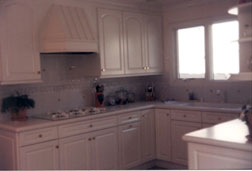

One of the materials that is gaining in popularity is quartz countertops. While it is possible to purchase solid quartz slabs, the option that you will find most is a composite quartz that also uses a resin filler much like the other solid surface materials. Quartz composites will be competitive with stone countertop prices, and are offered by many of the manufacturers that also offer synthetics. There are several trade names, such as Zodiaq. Silesonte, Cambria, Hi-Macs, Cesarstone, etc.
Stone: Natural stone is available in granite, marble, limestone, travertine, quartz, soapstone and onyx.
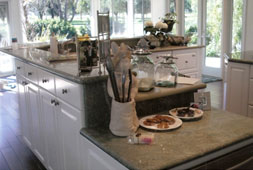
Granite is the material that is most often used for kitchen countertops, although marble makes a great baking counter because of its coldness. Granite and quartz are the most dense, and therefore, the most durable and easiest to take care of. Marble is a little more porous and can require more caution, especially if the material is honed (has the polish taken off).
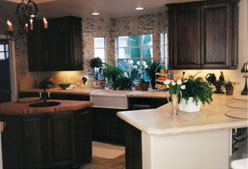
Limestone and travertine are even more porous than marble and will be more difficult to maintain due to staining issues. The cost is the biggest drawback, although there is a wide price range and you should ask your designer or the sales person at the "yard" where the material you like falls in terms of price.
Stone is typically 3/4" thick, although some material is imported in 3cm, which is 1-1/4". There is a broad range of edge details available with a full bullnose being the most common and usually the least expensive because it can be done by a machine. Others that have to be done by hand will add to the cost. The ability to undermount

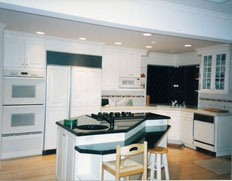
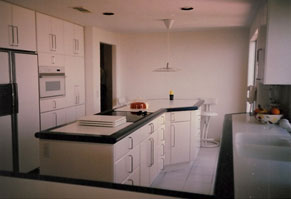
Butcher block: The best surface on which to cut and chop is wood and although butcher block is a beautiful natural material that won't ruin your knives, I have found that people are reluctant to actually use it. Butcher block typically is available in oak or maple, although more exotic woods can be specified. The edge details are the same as
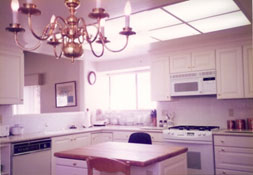
Stainless steel: Although it is a very cold and commercial look, stainless steel is a very sanitary and clean surface. It can be noisy when things are dropped on it, but it is pretty indestructible. It is not meant to be cut on, but it is impervious to heat. The cost is similar to tile and solid surface.
Concrete: A relatively new option in the marketplace, concrete has a natural and contemporary look. You may be thinking in terms of grey, but color can be added and various textures or finishes are available. I don't know anyone who will guarantee a concrete countertop will not crack. This, and finding an experienced contractor are the two biggest objections I have run into.
# # #
